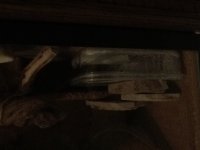hmarie186
New member

This isn't the first time I've seen this from Edgar. His poos and urates never looked like this before. When fresh they have a small mucusy looking blob but it's not like diarrhea/irritated colon mucus. When it dries it gets this yellow tinge and almost a crystal look to it. Here's the breakdown of everything so far:
He's been tested for crypto and parasites both negative.
Two different vets have told me it's nothing to worry about and he appears healthy.
Diet consists of a mix of blue bottle fly larvae, dubias and occasionally mealworms (we've cut them down to every other week because he is now on a low fat diet).
Roaches and mealworms are fed a mix of greens, oranges and sweet potatoes with Purina Layena crumbles as dry diet. It is fortified with vit A.
He was being supplemented twice a week with plain calcium and once a week with Reptivite with d3.
Urates have been about half yellow for several mos.
In the past 3 weeks he has barely went in his moist hide. I have changed the paper towels, used 3 different kinds of water (tap, bottled spring and zero water) and nothing makes a difference.
I have only seen him drink once ever.
Sheds normal, activity normal, appetite normal.
I suspected I was supplementing too much so the urate part has actually whitened up to almost 100% since I have stopped supplements for a week. My concern is that the reptivite has vit A and the sweet potatoes have vit a and too much is causing the yellow. Side note: Tidus has white urates. I was using carrots for the feeders and the yellow was worse. My other suspicion is he is not getting enough moisture between never drinking and now boycotting the moist hide. Could that cause the weird crystal looking yellow mucus thing? When fresh, there is still some watery moisture around his urate and poo. I am picking up some hornworms today or tomorrow to introduce some more moisture hopefully into his diet. Last time I bought them he ate a few and the rest turned into moths. :/ Has anyone ever has this issue and what causes it? I'm stumped!



